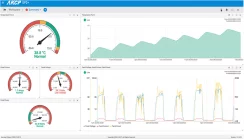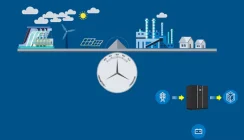Using Lead Acid v Lithium-ion Batteries in UPS Backup Solutions
When selecting a UPS system to protect your server room or other critical IT applications, how do you choose between a traditional lead acid battery for your UPS and the latest lithium-ion battery backup solutions? Whilst lithium-ion battery packs offer longer working lives, lead acid are the more cost effective and to a wider degree more environmentally friendly. The choice often comes down to cost, availability, and the application needs.
What Is an Uninterruptible Power Supply?
Most people are aware that a UPS system provides battery backup, but few are aware of the three major types of UPS available. The three types of uninterruptible power supply include:
- Online UPS systems: offers the most secure form of uninterruptible power when mains power supply is present and when a power outage occurs. The inverter is constantly running and powering the load using either a rectified mains power or generator supply or connected battery set. An automatic transfer switch (relay or static based) monitors the output from the inverter and automatically transfers the load to the raw mains power supply if the inverter output sine wave collapses during an UPS overload, short-circuit or fault condition. The UPS output is ‘no-break’ maintained by the seamless transfer between DC power sources (input rectifier output or battery) and the internal capacitance of the UPS system. Typical sizes range from 500VA to 1MVA, single and three phase UPS, monoblock and modular UPS types. As the UPS inverter is designed for constant running, this type of UPS is commonly used for extended runtimes using plug-in or hardwired external battery extension packs.
- Line interactive UPS systems: the next step down in uninterruptible power and typical available from 300VA to 3kVA, single phase. The UPS has an automatic voltage regulator (AVR) to which the load is connected and supplied a stabilised and filter AC waveform. The battery is charged by a circuit connected to the input AVR and an inverter is live but not powering the load directly. The inverter ‘switches’ in when the mains power supply fails or fluctuates outside the operating range of the AVR. The switching in time may be from 2-4milliseconds and the inverter output waveform from the inverter may be a sinewave or in lower cost models a square wave (referred to as a pseudo sinewave) or step-wave. Most IT loads can tolerate the break in supply and waveform due to the design of their switch mode power supplies (SMPS) which include their own capacitance (ability to store energy for a short period measured in milliseconds. The components in an IT power supply may be more stressed by the less conditioned output of a line interactive UPS (than an online one) but the real weakness of a line interactive UPS is its lack of an automatic bypass and inability to fail safely to mains if there is a UPS overload or fault condition. Line interactive UPS are more commonly used smaller IT loads and network devices. Some line interactive UPS can have extended backup times using external plug-in battery packs.
- Standby/Offline UPS systems: offer basic power protection and operate in a similar manner to a line interactive UPS. A filtering circuit provides some protection from electro-magnetic interference (EMI), spikes, transients, and surges. The off-line inverter powers up when there is a power outage in a time of from 2-4ms or more, the output waveform is a pseudo or square-wave and there is no automatic bypass. The battery backup is typically limited to an internal battery and this UPS type is available from 250VA to 1kVA typically.
In a typical UPS system, a battery is used to provide backup power when there is a power outage or unstable mains power supply. Lead acid batteries are ideal for this type of standby power application and this type of battery is the same as can be found in several other standby applications including generator starter sets, fire, and alarm panels. The primary type of lead acid battery used in a UPS is AGM (absorbent glass mat) but in larger online three phase UPS installations, flooded or wet cells can also be found.
So where does lithium-ion fit it and what are the key advantages compared to lead acid AGM or wet cells?
Lithium-ion Backup Batteries
Lithium batteries have been in development as a rechargeable backup power solution since around 1917. It is only in recent decades that the technology has evolved into the type of battery we commonly find in mobile phone, tablets and other products requiring a rechargeable battery.
The key benefits of lithium-ion batteries over lead acid types are their energy density, lack of memory and recharge times.
- Energy Density: is measured in Wh/L (Watt-hours per litre). Lead acid batteries can pack around 50-90Wh/L in a battery set compared to 125-600Wh/L for lithium-ion. Comparing the type of battery technologies can typically show lead acid sets requiring a volume (footprint and height) up to 10 times greater than a comparable lithium-ion backup solution.
- Memory Effect: battery memory can occur when a battery is repeatedly cycled (charged and discharged) before all of its stored energy is released. Memory effect used to be an issue in handheld video records and laptops in the 1980s and 1990s that used NiCad (nickel-cadmium) batteries. It was no unheard of for the battery to collapse quickly due to memory effect and therefore not provide the runtime expected. The only solution being to completely discharge the battery before the next recharge and usage.
- Recharge Times: the recharge of a lead acid battery is a non-linear curve. A rule of thumb is for the battery to recharge to 80% within 24hours, dependent upon the size of the charger used. This would typically be a temperature compensating battery charger than would go into a trickle charge for the last 20% of the recharge which could as long again to achieve 100% charge. Lead acid batteries are therefore ideal for standby applications where there is infrequent usage. The batteries are the partially or fully discharged before recharge. Lithium batteries are far more tolerant of rapid charge/discharge cycles and recharge faster, typically to 80% within 2hours and 100% within 4hours or less. A lithium-ion UPS battery set is also more temperature tolerant than a lead acid battery set which requires a 20-25⁰C ambient. For every 1⁰C rise above 30 their 5-year or 10-year design life halves. Lithium batteries can work up to 40⁰C and have 10–15-year design live expectancy.
Lead acid batteries are exothermic on recharge and give out heat when charging as the cells generate heat from the chemical reaction going on inside them. Thermal runway is unlikely in a lead acid battery and the primary flammable material (the plastic case) can be made from flame retardant materials complying to BS6290 Part 4.
In a lithium-ion battery, the lithium itself is highly flammable when exposed to air (oxygen). Whilst vehicle manufacturers have been quick to embrace lithium batteries to move away from fossil fuel engines, they are very conscious of the potential thermal runaway problem of lithium-ion batteries. A fire can start if the battery is cracked (during a car crash) or has a manufacturing defect leading to an area where heat can build-up leading to thermal runway and potential fire. A fire that due to nature of the combustible material can take days to put out and cool.
More information on battery types:
http://web.mit.edu/evt/summary_battery_specifications.pdf
https://www.cummins.com/news/2019/06/17/spot-difference-lithium-ion-versus-lead-acid-battery-electric-technology
UPS Systems : Lead acid or Lithium Battery Backup?
The first point to note is that not all UPS manufacturers offer lithium-ion powered UPS systems. Those that do provide limited offers in their UPS ranges. For example, a UPS manufacturer may offer smaller single-phase UPS up to 2-3kVA with lead acid or lithium-ion battery options. These are specific UPS systems designed to work with the respective battery technology and they are not interchangeable. The reason being the unique charging and management characteristics of each type of battery. Prices will also be different with a 20-30% premium being charged for lithium, whether the UPS is an online, line interactive or standby system.
For larger online uninterruptible power supplies, a UPS manufacturer will offer discrete systems or solutions that can be charge either lead acid or lithium batteries. The option is often a firmware setup choice on installation. Again, there will be a price premium for lithium over lead acid. A point to note is that as the size of the UPS in kVA/kW increases so does the size of the UPS battery.
With larger sets this can mean the installation of a sizeable battery within a server room or data centre and if the battery is lead acid, fire suppression should be a key consideration in a risk assessment. If thermal runway were experienced this could lead to fire in the room and the need to evacuate safely and suppress the fire. In addition to a fire suppression system, placing the UPS system and lithium battery set in a separate UPS room that can provide containment of any such and rare issue could help to further reduce the impact of such an event.
UPS Battery Recycling
At their end of useful life, recycling lithium-ion batteries is a major issue. For lead acid batteries there are multiple established recycling centres and companies. Ups to 90% of a lead acid battery can be reclaimed and recycled including the plastic case, lead terminals & plates, and hydrochloric acid. This is not the case for lithium-ion batteries.
Almost everyone with a mobile phone has become accustomed to the features and benefits offered by lithium-ion battery sets. Older handsets are often sold-on to the second-user market and if a battery requires recycling it is important to place this in the correct waste stream and to consider the battery as general waste.
Lithium battery recycling for electric vehicles (EV) is a problem. So far there is only one dedicated recycling centre in Belgium, Europe. Most of the time EV batteries are repurposed into applications where they can be used for energy storage. Over time the number deployed whether in mobile goods, EVs and UPS systems could lead to a major recycling problem. It is extremely difficult and costly to break down a lithium-ion battery into its components for recycling. Until this problem is solved, and lead acid batteries are on a par for first purchase and recycling, lead acid remains the most sustainable technology.
Summary
Today, lead acid batteries remain the first choice for uninterruptible and backup power systems. Not only are they more cost effective when it comes to their purchase, but they are also easier to recycle. Lithium battery installations require less floorspace and offer faster charge/discharge cycles & design lives have a 20—30% greater capital outlay. The are also other installation expenses to consider including environmental monitoring and fire suppression. Lithium therefore has still some way to go before it can dislodge lead acid as the ‘go to’ battery type for UPS installations. Above all the choice depends on how often you expect your UPS battery to discharge. In a typical server room or data centre the UPS battery will either provide short term power as a standby power generator starts up or a longer runtime (using battery extension packs) to either ride through long duration power outages or provide enough time for a controlled shutdown. The fast recharge/charge advantages of lithium only come into play if the site experiences frequent power outages and/or is looking to export excess stored energy to a national grid to benefit from feed-in tariffs. Whilst these may be financially attractive, exporting to an electricity grid could reduce the overall resilience and purpose of the UPS system – to protect critical loads from power outages.


























